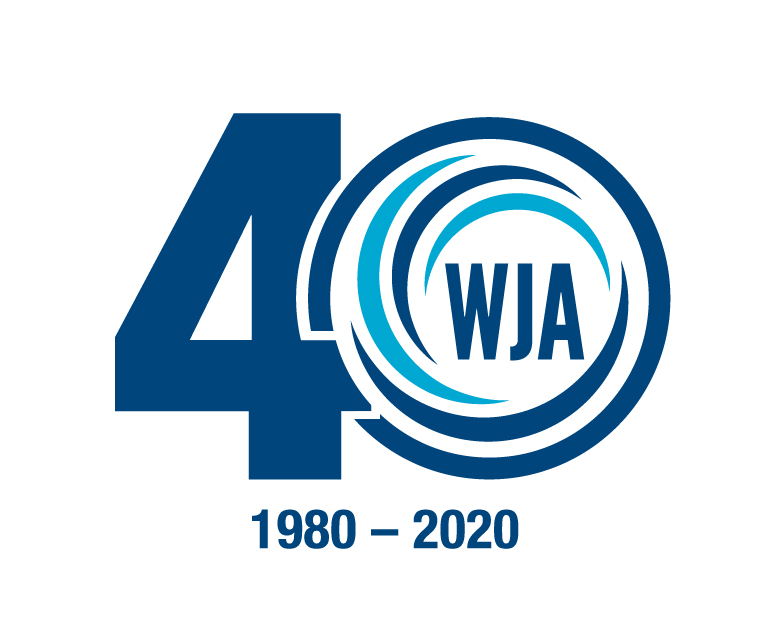Keeping the Pressure on Safety – The WJA at 40

It is 40 years since the founding of the Water Jetting Association. In its October 2019 edition, Drain Trader magazine published this feature, in which WJA Director David Kennedy explained the WJA’s driving force and why its work is as relevant as ever.
It began with a meeting between a handful of business people at Birmingham Airport in October 1979. Pioneers in a fast-growing industry set aside competitive instincts to establish the first body to oversee water jetting in the UK. Their primary purpose: to promote safety across the industry.
Now, 40 years on, the Water Jetting Association (WJA) is recognised as the leading body for the water jetting industry in the UK, and as an organisation that has probably done more than any other in the world to define best practice in water jetting in terms of both health and safety and operational effectiveness.
The WJA has members in all sectors where water jetting is an element of an industrial service, not least the drainage industry. When it was first set up, it had around eight members. Now, the WJA has more than 200, and that number is growing every month.
Pioneering water jetting standards
Water jetting had been used, primarily to carry out industrial cleaning, at least since the 1940s. By the 1970s, with new and ever more powerful water jetting systems coming onto the market, and a wider range of applications being identified, there was concern that the industry lacked structure and control.
It is no surprise then that a key player in the formation of the WJA was the Health and Safety Executive (HSE). It advised leading water jetting contractors that, if they did not work together to establish clear standards, the agency would have to step in and seek to do it.
That led to the inaugural meeting of what was first called the Association of High-Pressure Water Jetting Contractors (AHPWJC). Attendees at that first meeting included: Douglas Walton, of Walton Mole; Allan Earnshaw, of Neolith Pumps, who went on to build Lanes for Drains, now Lanes Group plc; Bill Crompton, of Waterblast Ltd; and Mike Donaldson, of SLD Pumps.
Also closely involved was Roland Taylor, who went on to found Jetchem Systems Ltd.
Over the years that followed, it was recognised that a broader brush approach was needed – with a wider range of players involved in guiding the future of the water jetting industry.
Representing all who use water jetting
The WJA’s constitution was amended to open membership to other organisations and people, including manufacturers, drainage contractors, hirers and trainers, who all had a key role to play in shaping the success of the water jetting industry.
At the same time, the power and sophistication of water jetting systems was increasing. When the WJA was first formed, high-pressure water jetting was considered to be pumps operated at and over 10,000 pounds per square inch (PSI) of pressure. Now, WJA members commonly using pressures of 40,000 PSI and even up to 60,000 PSI.
An important decision the WJA took in its first 12 months, was to establish a water jetting Code of Practice. It was not an easy task. Contractors were using a wide range of equipment, some of it custom-made. They worked in different sectors, and had different opinions on what safe and efficient practice looked like.
Codes of Practice – setting a global lead
That is one reason why the first Code of Practice for the Use of High Pressure and Ultra High Pressure Water Jetting Equipment was not published until 1982, some three years after the WJA was first formed.
However, it turned out to be a good platform to build on. The Code of Practice has been through nine amendments or revisions. In 1993 it became the ‘Blue Code’ familiar today, a version that was approved by the HSE as setting the recognised industry standard for water jetting. A newly- revised edition, the first since 2015, is due out very soon.
Following on from the Blue Code of Practice, the Red Code of Practice for the Safe Working and Use of Water Jetting in Drains and Sewers was published soon after drainage contractors joined the WJA.
Again, that code has been though six reprints, presenting opportunities for updates to be made, based on the advice of representatives from contractors, manufacturers, hirers and trainers who sit on WJA committees and its Ruling Council.
The Red Code incorporates key elements from the Blue Code, plus specific sections relating to health and safety and operational issues for drains and sewers, for example: exposure to sewage, micro-organisms, sewer maintenance, jetting heads and safety leader hoses.
The WJA has been an international leader in developing these standards. There are water jetting associations in other countries, including the USA and on the Continent, but none have safety and operational standards as advanced as the UK.
Exciting training developments for 2020
The other key foundation of the WJA’s work is training. The association is by far the largest provider of water jetting training in the UK. Nearly 9,000 people a year attend the WJA’s Health and Safety Awareness course and practical modules, which are accredited by City & Guilds of London Institute.
Again, establishing training standards took time. It was not until 1993 that the first fully constituted and agreed upon water jetting Safety Awareness course was ready to be rolled out. Since then, like the Codes of Practice, WJA training has moved with the times. All training is provided by WJA- registered Training Providers and WJA-Approved Instructors.
The association works constantly to maintain the relevance and consistency of training courses. The one-day class-based Safety Awareness course is now offered alongside practical hands-on modules, including: Drain and Sewer Cleaning (DS), Surface Preparation (SP), Tube and Pipe Cleaning (TP) and Hydrodemolition (HD).
In the last 12 months, in a process led by our Vice President and the Chairman of our Training and Safety Committee, John Jones, the WJA has been preparing significant innovations to our training offer.
The aim has been to make sure water jetting operatives have the awareness and the skills they need when they start working in the water jetting industry and throughout their careers.
For example, from January 2020, all operatives will be required to pass the Safety Awareness Course and a relevant practical module to be registered on the WJA database and receive their WJA Photo-ID Card. Currently they must only pass the Safety Awareness course. This ensures operatives go into the field having had relevant, structured practical ‘hands on’ training.
We are also introducing a Safety Awareness workbook, giving training delegates a more engaging learning experience, which they take away with them. This is in addition to the recent revision of training course content, making it more visual and easy-to-follow for people with all educational experiences.
During 2019, we also revised the questions in the end-of-course test for the Safety Awareness course to ensure they are easy to follow and fully test our delegates’ knowledge.
Also, in 2020, we are introducing a Level 2 water jetting qualification for managers. This is aimed at managers responsible for operations that use water jetting but who may not be directly involved in water jetting delivery.
New Medical Guidelines will save lives
We recognise that the WJA must move with the times. That includes responding to technical developments, seeking to set the highest standards of health, safety and wellbeing, and representing the interests of our members in discussions leading to the development of industrial regulations.
That is why, we commissioned research from an eminent group of trauma doctors and surgeons into the best practice management of fluid injection injuries, one of the most serious types of injury associated with water jetting.
That will allow us to publish new Water Injury Management Guidelines in our Codes of Practice. For the first time, they include a detailed algorithm for effective injury response, from giving first aid to hospital treatment, which promises to save lives and reduce the impact of injury.
The research findings have been published in the European Journal of Trauma and Emergency Surgery, so the good practice can be shared with medical specialists throughout the world.
Leading on water jetting into the future
The water jetting industry has changed markedly in the 40 years the WJA has been in existence. Higher operating pressures have moved hand-in- hand with other innovations.
These include the development of robotic systems and new applications, such as precision cutting. More sustainable technologies have been developed, like jet vac recycler units and more advanced jetting systems that use less water.
The WJA aims to stay at the forefront of these developments. We will continue to champion the benefits of water jetting, its safe application and the interests of our members.

